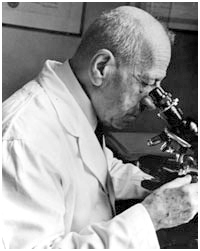
Many women owe their lives to the physicist, who gave his name to the most famous PAP test, which is used to detect premalignant and malignant processes in the cervix. The name of the pathologist is George Papanicolaou (1883-1962) and the test was developed in 1928.
George Papanicolaou’s father was a physicist and it was his will for his son to study medicine. During the Balkan war in 1912, the young Dr. Papanicolaou meets some Greek-American soldiers and decides to leave for the US, where he starts his career in the science field and researches.
In 1928 Papanicolaou finds out that malignant processes in the cervix can be detected with a cytological test. Relatively simple and painless, this procedure can be done in any doctor’s office or clinic.
The procedure consists of taking some samples from the cervix membrane with the help of cotton spatulas or small brushes (brushes are preferred during the last years), which later on are colored and examined under a microscope. It is recommended that women and girls, who are sexually active, to undergo the PAP test once a year.
The medical community needed some years before it recognized the importance of the PAP test, which was widely applied for the first time in 1960 – two years before Papanicolaou’s death.
George Papanicolaou is the author of more than 150 publications and is the carrier of many awards. He died on February 18, 1962 from a heart attack and a pulmonary edema, and he was buried in New Jersey. The PAP test saves the lives of millions of women and establishes cytology as the main diagnosis method.
In 2008 The Hellenic Medical Community in New York published a book called “Life and career: The road to PAP test discovery,” dedicated to Dr. George Papanicolaou – founder of the community in 1936 and its first chairman.